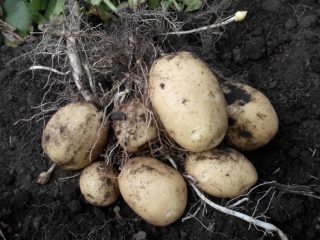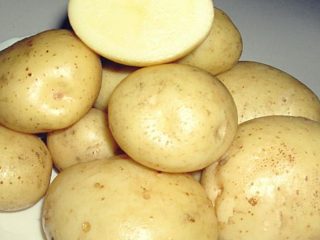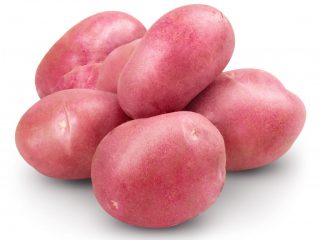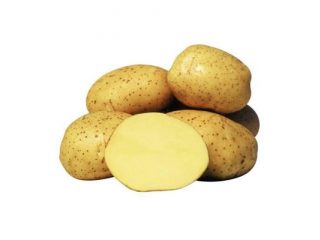Content
Spiridon potatoes are a variety suitable for both amateur gardeners and professional farmers. It's not unique or outstanding, but it's a reliable workhorse. The variety consistently produces very good yields, despite the influence of climatic and weather negative factors, and with minimal care it rarely suffers from diseases and pests. The “culinary” purpose is universal; the tubers look quite presentable and have a good taste.
History of selection
Potato Spiridon is a variety created in 2001 by specialists from the Ural Federal Agrarian Research Center of the Ural Branch of the Russian Academy of Sciences. The organization is the originator; S. V. Novokreshchenov, V. P. Dergilev, V. S. Kozhemyakin are indicated as authors.
Official variety trials lasted for six years. Upon their completion, the Spiridon potato was included in the State Register of Breeding Achievements of the Russian Federation in 2007.
Description of Spiridon potato variety
In appearance, it is difficult for a non-specialist to distinguish Spiridon potato bushes from other varieties and hybrids. Its tubers also do not stand out for their unique “appearance”.
Bush
Spiridon potato bushes reach 60-70 cm in height. The root system is powerful, the stems are semi-erect, the plant is not too spreading. The leaves are medium in size, with a “classic” rich green hue for the culture. The leaf blade is almost smooth, without pronounced “wrinkling” and “wavy” edges.
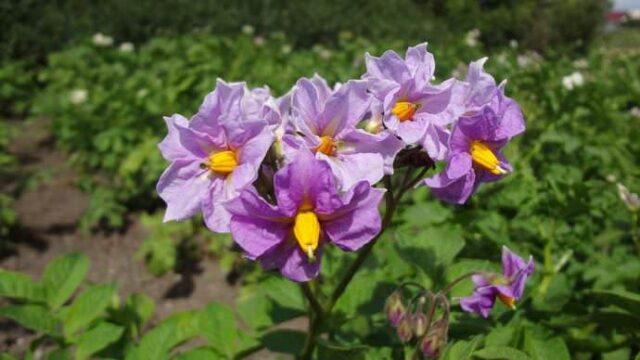
The inflorescences of the Spiridon potato are relatively small, the flowers are of a rich lilac hue, often with a burgundy undertone
Tubers
Tubers of the Spiridon variety are regular elliptical or round-oval in shape. The skin is thin, almost smooth, red-pink or crimson in color. The size of the tubers is average or larger than average (105-140 g). There are practically no “trifles” unsuitable for cleaning in the nests.
The pulp is elastic, quite dense, creamy or has the shade of butter. The starch content in it is 12-15.8%. This is due to the slight “crumbiness”.
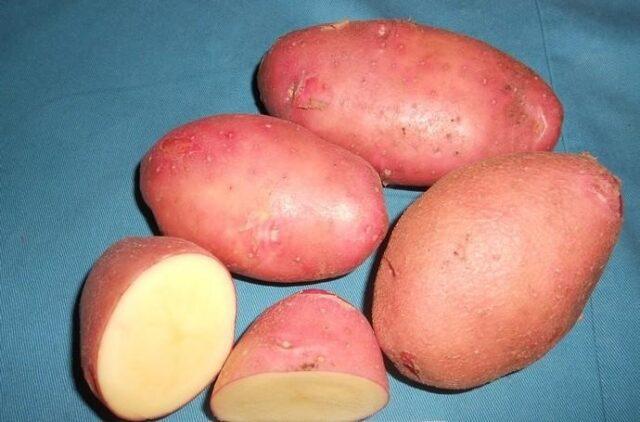
The “eyes” in the tubers are very small, superficial, there are few of them
Characteristics of potatoes Spiridon
When choosing potatoes for cultivation on your own plot, first of all you need to take into account not the appearance and size of the tubers, but other varietal characteristics. Among the factors that are fundamentally important for gardeners are the time of ripening and the volume of the harvest, the presence of immunity against certain diseases and protection from pests, and suitability for cultivation in a particular region.
Taste qualities of potatoes Spiridon
Spiridon is a table potato. It definitely cannot boast of outstanding taste qualities; professional tasters rate them as “good”.However, most gardeners and other “consumers” are quite happy with it.
Ripening time
Spiridon is a mid-season potato variety. Between the appearance of “mass” shoots and harvesting in the Urals and central Russia, 90-110 days pass. However, in the southern regions, subject to high-quality care and sufficient watering, tubers can ripen 1-1.5 weeks faster - there this variety is considered a mid-early variety.
Productivity
According to the results of variety trials, the yield of the Spiridon variety is estimated at 138-278 centners per hectare. The very large “scatter” can easily be explained by the specific climatic features of different regions and weather conditions during each specific season. In terms of yield, the Spiridon potato was not inferior to the Lugovskoy and Krasnopolsky varieties chosen as the “standard”. The “record” (392 c/ha) was recorded in the Kurgan region.
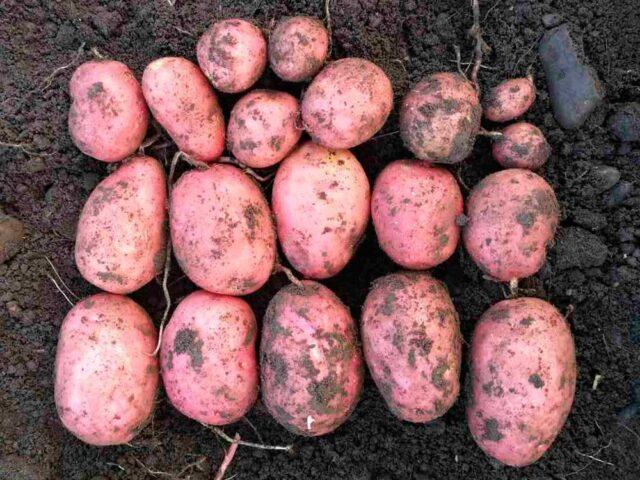
According to the originator, higher yields are possible - up to 500 c/ha
When growing Spiridon potatoes on personal plots, 10-16 tubers are formed in one nest. Accordingly, an amateur gardener can count on 1.5-2 kg per bush.
Where is it grown?
The State Register of the Russian Federation officially recognized the Spiridon variety as the most suitable for cultivation in the Ural region.During variety trials, it showed its best performance in Bashkortostan, Kurgan, Chelyabinsk, and Orenburg regions.
However, the experience and reviews of gardeners from other Russian regions, as well as from the former republics of the USSR, suggest that it successfully takes root and consistently produces yields almost everywhere where climatic conditions, in principle, allow farming. The potato variety Spiridon, zoned for the Urals, is initially distinguished by its endurance, “stress resistance” and a certain “plasticity”.
Disease resistance
The general hardiness of the Spiridon potato includes its good resistance to pathogenic microflora, with the only exception (late blight). However, it does not have “innate” immunity against pathogenic fungi; it cannot do without pre-planting and preventive treatments.
Breeders provided the Spiridon potato with protection against an incurable disease - bacterial cancer. During the tests, it was noted that it is extremely rarely affected by golden nematode, rhizoctonia, and scab.
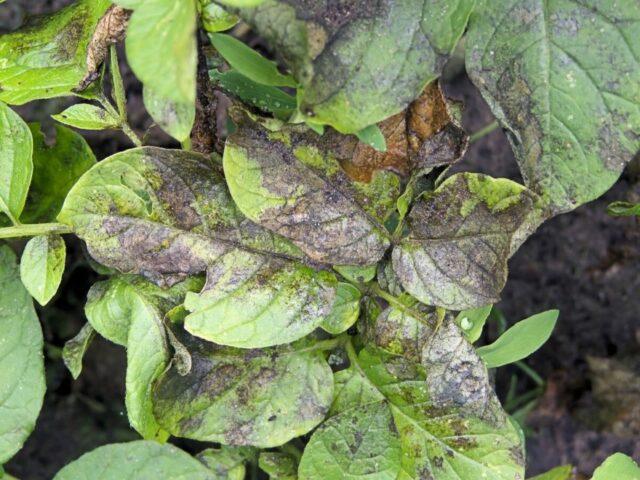
The most dangerous disease for the variety is late blight, and the above-ground parts of plants are more susceptible to this fungus than tubers.
Advantages and disadvantages
Spiridon potatoes are suitable for making soups, purees, and frying. After cutting, the pulp does not darken or turn gray and retains its shape.
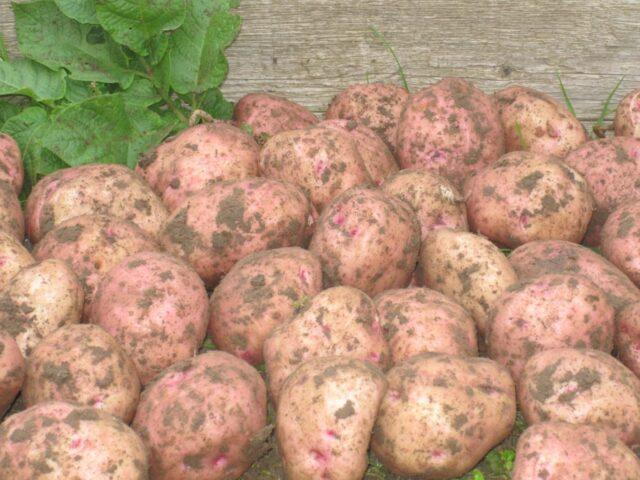
The vagaries of the weather have virtually no effect on the taste of Spiridon potatoes
Pros:
- stable and fairly high productivity, little dependent on the negative influence of “external” factors;
- ability to adapt to a wide range of climatic and weather conditions;
- external presentability, correct shape and one-dimensionality of tubers, almost complete absence of “trifles” unsuitable for use in cooking, planting for the next season and long-term storage;
- suitability of Spiridon potatoes for preparing any dishes;
- the presence of immunity against bacterial cancer, extremely rare cases of infection by the golden nematode, generally high resistance to pathogenic fungi;
- very good keeping quality.
Minuses:
- tendency to be affected by late blight;
- "standard" taste;
- relatively low transportability.
Landing Features
In the Urals, Spiridon potatoes are planted in the first half of May, in central Russia - in the last days of April. You need to wait until the substrate warms up to a temperature of 9-10 °C. A folk sign - buds blooming on birch trees - becomes a fairly reliable guide.
Spiridon potato tubers selected for planting in the fall are inspected again, rejecting any “substandard” ones. Pre-planting treatment necessarily includes not only germination, but also dressing in a solution of any fungicide to prevent infection with late blight and other pathogenic fungi. Also, many gardeners practice treatment with biostimulants, which has a positive effect on the cold resistance of tubers and helps increase productivity.
To plant Spiridon potatoes, choose an open place, well heated by the sun. It does not need an excessively nutritious substrate; moderate fertility is sufficient. More important for the normal development of tubers is soil looseness and a neutral or slightly acidic pH.The selected area is dug up last fall, adding humus and other fertilizers in the process, adjusting the acid-base balance if necessary and getting rid of weeds.
Potato tubers of the Spiridon variety are planted at intervals of 30-45 cm, leaving 75-80 cm between rows. The approximate depth of the holes is 10-12 cm.
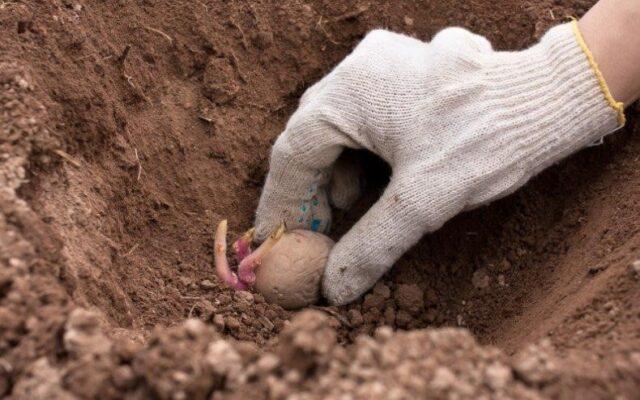
At the bottom of the hole you can throw a handful of humus mixed with coarse sand or wood ash
Care instructions
Spiridon potatoes are a suitable variety for an inexperienced gardener; caring for them includes only basic agrotechnical measures:
- Watering. Spiridon potato bushes often have enough natural rainfall throughout the season. But there are “critical moments” when they especially need water - 10-12 days after “mass” germination, after the formation of buds and immediately after flowering. If the soil is dry at this time, the number and size of tubers will noticeably decrease.
- Feeding. Spiridon potatoes react positively to both natural organic matter and folk remedies, as well as complex store-bought fertilizers. During the season it is fed three times - when the stems grow to 8-10 cm in height, during flowering and 10-12 days after it. At an early stage of development, plants need more nitrogen, then phosphorus and potassium.
- Hilling. The bushes of the Spiridon potato are quite tall, but they “fall apart” infrequently. They must be hilled twice, then as needed, but not more than twice a month.
- Prevention of diseases.To prevent the development of late blight, Spiridon potato bushes are sprayed monthly with a solution of any fungicide. When rainy, cool weather sets in for a long time, the interval between treatments is reduced to 2-3 weeks.
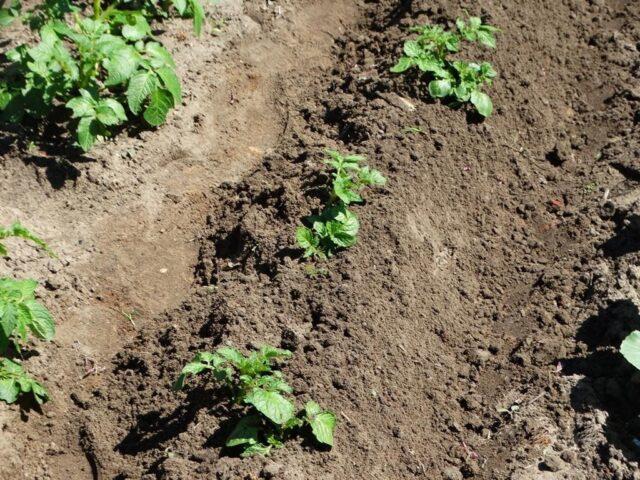
Potatoes need regular hilling, for example, when ripening tubers “show up” from the ground
Harvest and storage
The ripening period of Spiridon potatoes depends on the growing region. In the Urals, the harvest is most often harvested at the very end of summer or in early September. But it is better to focus on the condition of the bushes, waiting until the tops are completely dry and the stems lie on the ground.
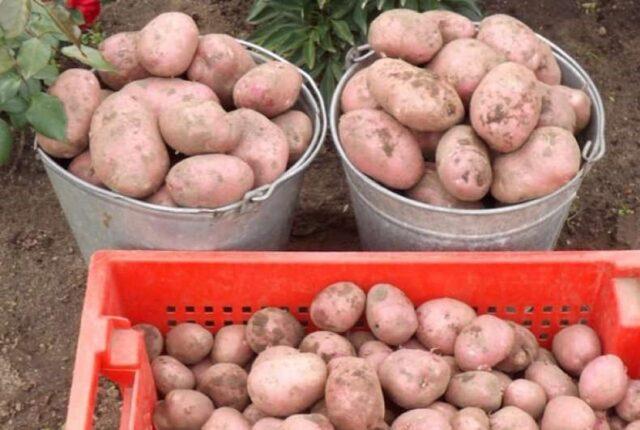
There is no rush to dig up potatoes - unripe tubers do not have a rich taste and are poorly stored
On personal plots, potatoes are dug using a shovel or pitchfork. However, the Spiridon variety is also suitable for mechanized harvesting. The harvest is immediately sorted, getting rid of specimens unsuitable for long-term storage. “Conditional” tubers are left to dry in the open air for 2-3 days, protected from precipitation and direct sunlight. You can also dry them in a room with good ventilation at a temperature of 15-18 °C.
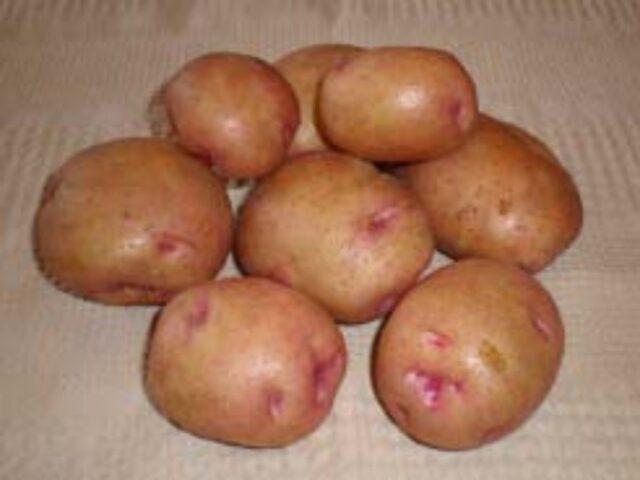
Planting material for the next season is stored separately from the main part of the harvest.
The method of storing Spiridon potatoes does not fundamentally affect their keeping quality. However, the following conditions must be created for the tubers:
- air humidity 65-75%;
- temperature in the range of 2-4 °C;
- constant access to fresh air (but not cold drafts);
- darkness.
Conclusion
Spiridon potatoes are not without certain disadvantages. But in the eyes of the majority of gardeners and farmers who have tried to grow it, some of the disadvantages are more than offset by the reliability and hardiness of the variety. It is valued not only for its “stress resistance”, but also for its good immunity, good taste, presentable appearance of tubers, and consistently high yields.
Reviews from gardeners about Spiridon potatoes

